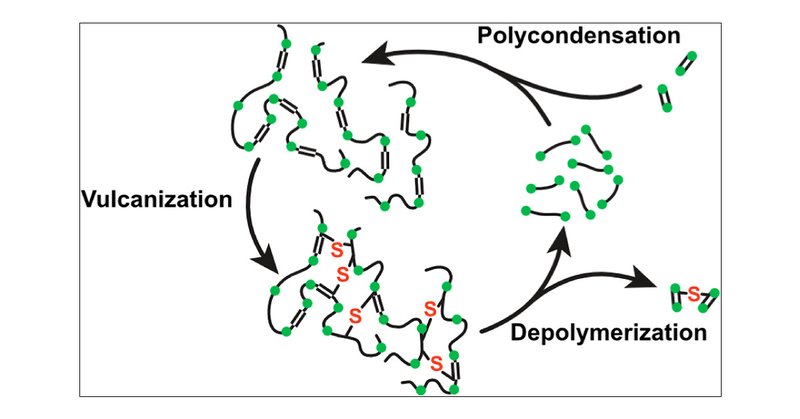
Taylor Frederick Nelson
@TaylorFNelson
Followers
97
Following
121
Media
8
Statuses
46
Environmental Chemist Postdoc @MeckingGroup @UniKonstanz Biodegradation of polymers in the environment. My latest work: https://t.co/GK1PFFjPAY
Joined November 2020
Can we make polymers from broad mixtures of monomers with diff. lengths (e.g., aliphatic diacids made from cat.-ox. of waste PE)? 🗑️➡️⛓️ What kind of materials might we be able to get? Read below in @angew_chem to see some 1st answers! @MeckingGroup
https://t.co/qSRZVsyVcl
onlinelibrary.wiley.com
Polyesters derived from multiple chain length dicarboxylate feedstocks, as obtained from valorization of waste polyethylene or oxidation of bio-based fatty acids, exhibit high density polyethylene-...
1
2
7
We are thrilled to announce our newest publication in @ACSSustainable We report the successful synthesis of a biodegradable vulcanized polyester-based rubber exhibiting elastic properties. Solvolysis to the monomer enables recycling. Check it out: https://t.co/sCVmcQ4PED
pubs.acs.org
The cross-linked nature of vulcanized rubbers as used in tire and many other applications prohibits an effective closed-loop mechanical or chemical recycling. Moreover, vulcanization significantly...
0
1
13
0
0
0
These bio-based polymers 🌿 ⛓ show ductility and applicability in thermoplastic elastomers, as well as enhanced biodegradability compared to their linear analogs 💥
1
0
0
📜 Our latest manuscript is online, in which we report long-chain aliphatic polyesters from 2,3-butanediol 🦠 Check out open access publication here 👇
1
0
2
Degradable and Recyclable Polyesters from Multiple Chain Length Bio- and Waste-Sourceable Monomers (Stefan Mecking and co-workers) @MeckingGroup #OpenAccess thanks to #ProjektDEAL
onlinelibrary.wiley.com
Polyesters derived from multiple chain length dicarboxylate feedstocks, as obtained from valorization of waste polyethylene or oxidation of bio-based fatty acids, exhibit high density polyethylene-...
0
3
11
On the back of a new publication using this method 🛠️, I received an email today that 1 year out from publication our manuscript on tracking 🔎13C-labelled biodegradable 🌿polymers⛓️ in @NatureComms has been downloaded over 7,000 times! 🤯 Check it out open access below 👇
With biodegradable plastics, we want to be sure that they actual biodegrade, right? 13C-labelling of poly(butylene succinate) unequivocally showed biodegradation in soil and let us precisely close mass balances on polymer-C. https://t.co/a4kDMCNXkW But that’s not all…
0
0
5
Could we make recyclable and degradable polyesters from #biowaste? @TaylorFNelson and colleagues show that the small monomers found in feedstock or #biomass can be used to make longer chains. This could be the next step towards closed-loop #recycling. https://t.co/MZecducCeo
onlinelibrary.wiley.com
Polyesters derived from multiple chain length dicarboxylate feedstocks, as obtained from valorization of waste polyethylene or oxidation of bio-based fatty acids, exhibit high density polyethylene-...
0
1
5
We are highly excited to annonce our newest publication about polyesters from multiple chain length bio-based monomers and their degradation in @angew_chem Check it out here: https://t.co/v71kLT2Fye Congrats to everyone involved. @TaylorFNelson
onlinelibrary.wiley.com
Polyesters derived from multiple chain length dicarboxylate feedstocks, as obtained from valorization of waste polyethylene or oxidation of bio-based fatty acids, exhibit high density polyethylene-...
0
2
7
@angew_chem @MeckingGroup We used model systems of diacids with diff. lengths to make ductile, recyclable, degradable polyesters in collab. with M.Sander @usys_ethzh. Shows possibility to make polymers from mixed-monomer feedstocks, incl. ox. PE waste, or bio-based source materials!
0
0
1
A week in Woods Hole flew by! Lots of good work on the NMR with great @WHOI colleagues @bdbjames @Chris__Reddy Yanchen Sun & Collin Ward. Looking forward to more cool stuff! For some info on what we’ve been up to see our paper in Analytical Chem on DOSY for plastics! 👇
2
2
9
Enjoying San Francisco and the start of the #ACSFall2023 meeting! I will present Monday 14:30 in Moscone West 3006 in the ENVR section And have a poster Tuesday from 19-21 in Moscone Hall F in the PMSE section
0
2
11
Main applications we highlight are analysis of consumer plastics and following polymer transformations, such as environmental Photodegradation. See more for yourself! Open Access!
1
0
0
We also applied DOSY to different polymers to highlight the wide applicability thermoplastics + water-soluble polymers. Can greatly reduce solvent req. and throughput compared to GPC/SEC!
1
0
0
We highlight some important considerations for preparation of polymer samples for DOSY. A key is concentration which of course effects solution viscosity and therefore diffusion! But, DOSY can be applied across a range of conc., which could have different advantages
1
0
0
Are you interested in🔎analytics of polymers , esp. regarding⛓️molecular weights ? esp. consumer plastics in the environment🌿? Read about characterizing polymer MW easily with just an NMR! 🧲 Work done at @WHOI👇Open-access✅in Analytical Chemistry📊 https://t.co/FQh10pK01C
pubs.acs.org
Molecular weight (MW) is a key control of plastic polymer properties and their fate in the environment. However, the primary tool used to determine plastic MW, gel permeation chromatography (GPC),...
2
9
17
Enjoyed the last days at @APME2023 in Paris 🇫🇷! Got to highlight some work I am doing in @MeckingGroup, and tried to put in context to my overall research on polymers in the environment ! 🌱
2
1
9
I was happy to participate this is great work🧑🔬in my research group @MeckingGroup at @UniKonstanz ! (press release below) We presented a strong HDPE-like 💪 polyester that shows enzymatic hydrolysability 🦠and compostability Find it open-acess 👇 https://t.co/8M9iYqQYrf
onlinelibrary.wiley.com
While it resembles high density polyethylene with regard to its mechanical properties and solid-state structure and has a high melting point (Tm=96 °C), the novel polyester-2,18 material at the same...
A polyester plastic of great mechanical stability, which is also easily recyclable and even compostable: Stefan Mecking, #UniKonstanz chemist, and his research group present a new material. Details: https://t.co/2mPR7ZIwAZ
@GDCh_aktuell
0
4
11







